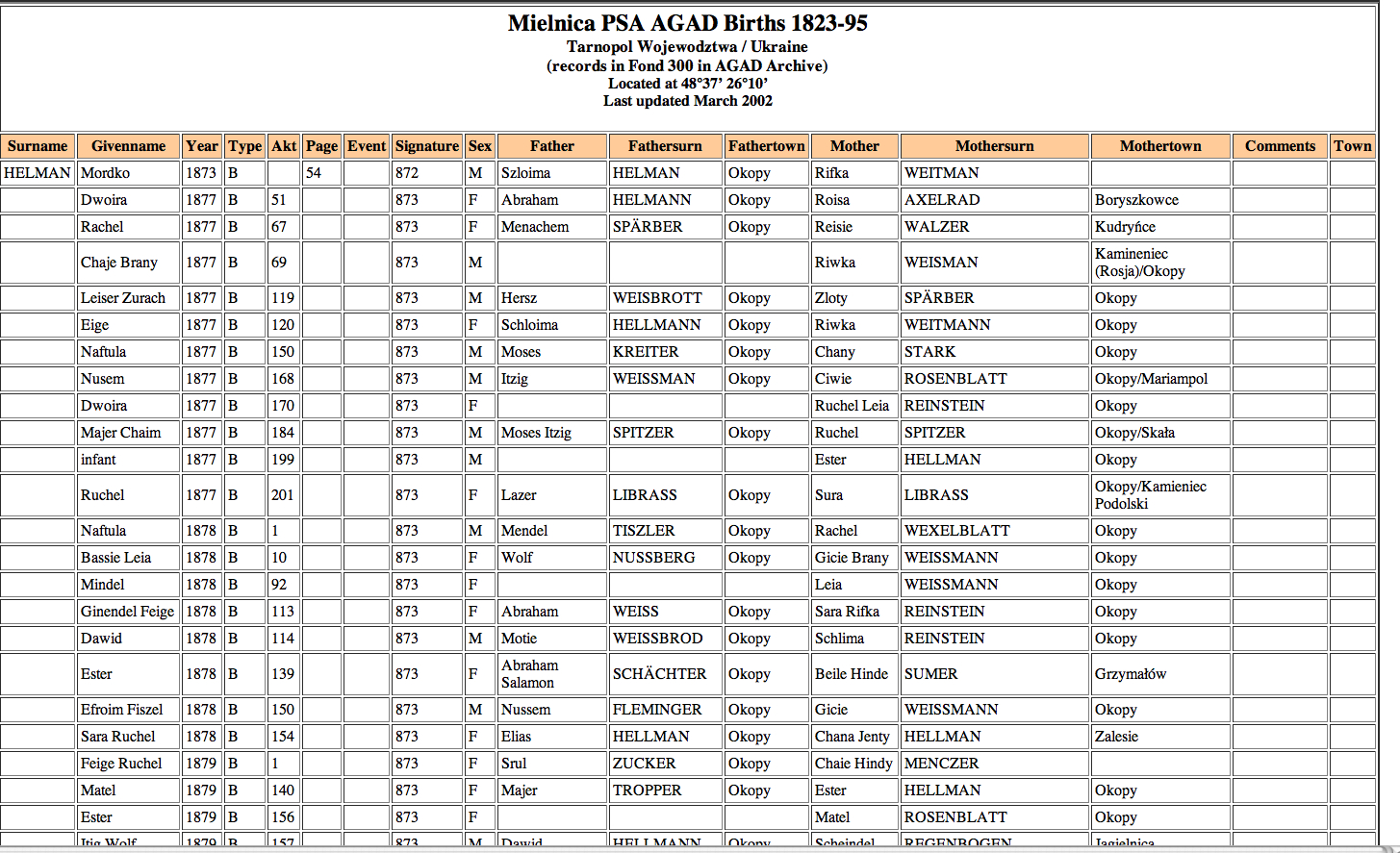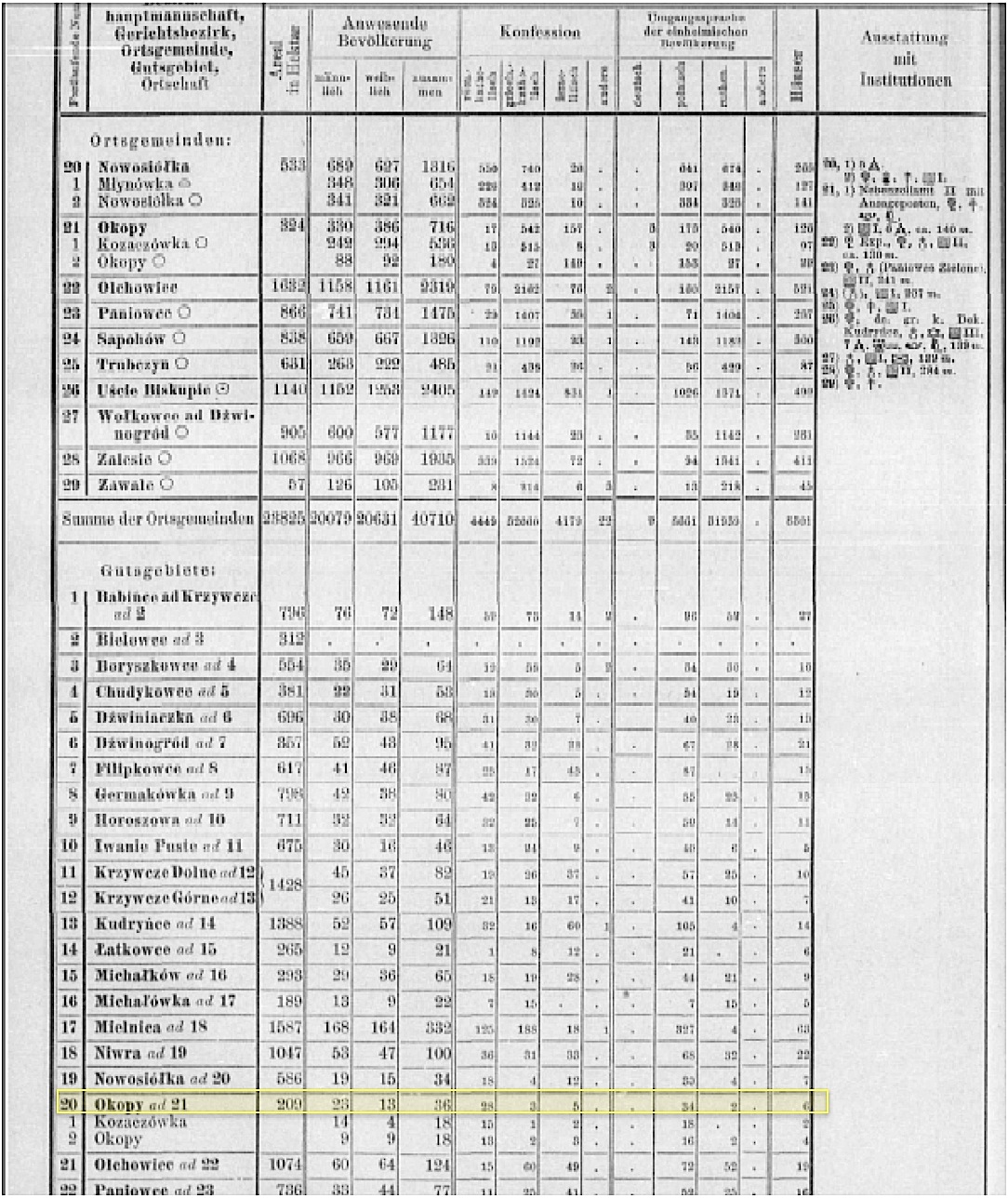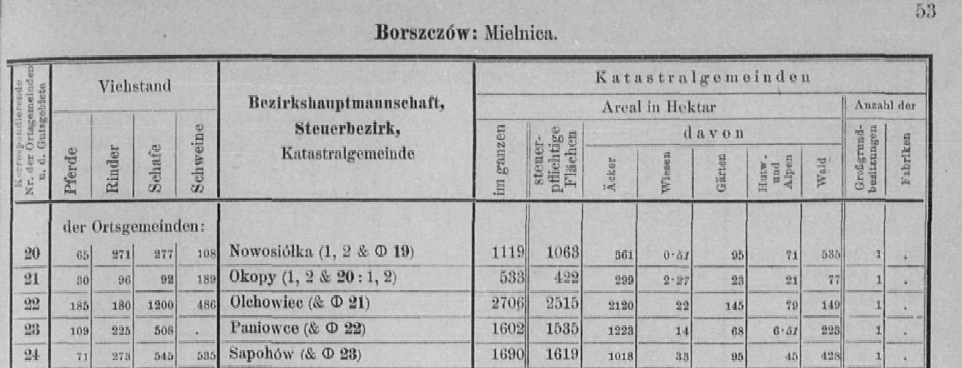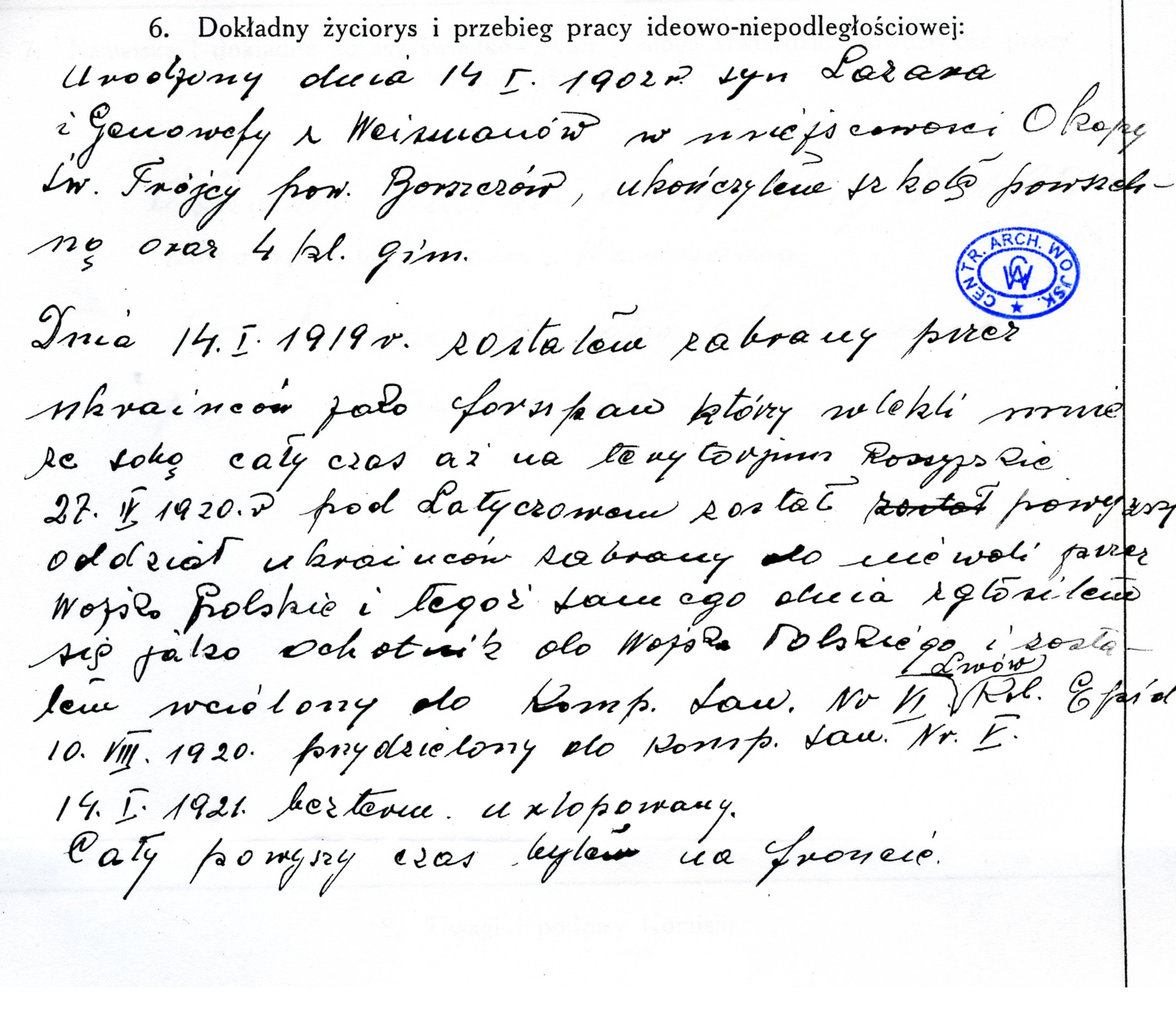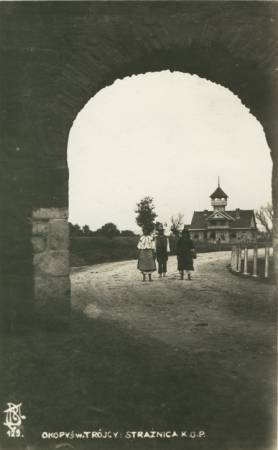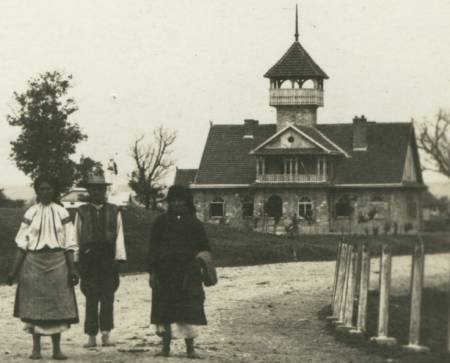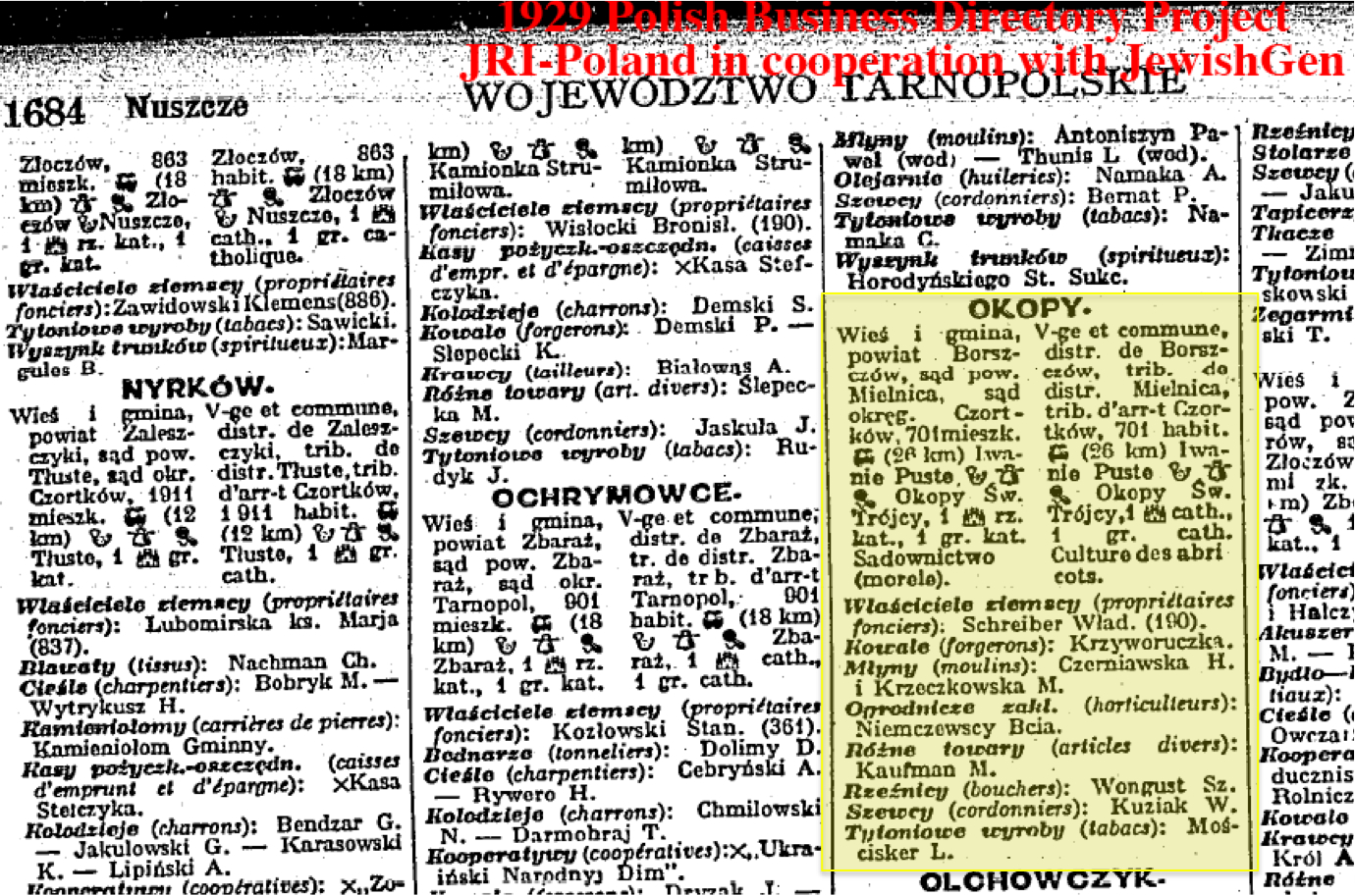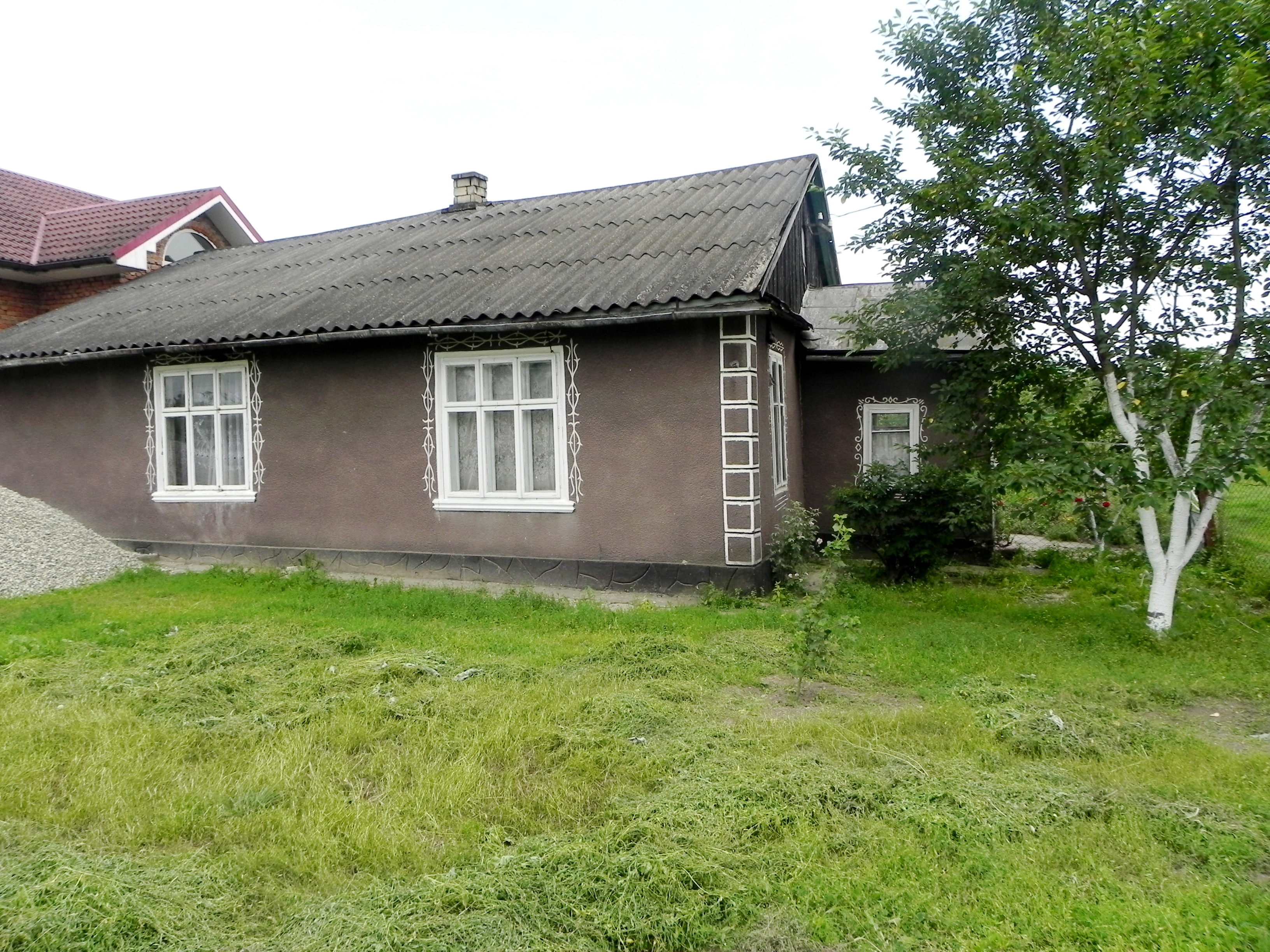| What is interesting is that the socioeconomic split in Okopy Swietej Trojcy in the 1920's is negatively correlated with the ethnic split. |
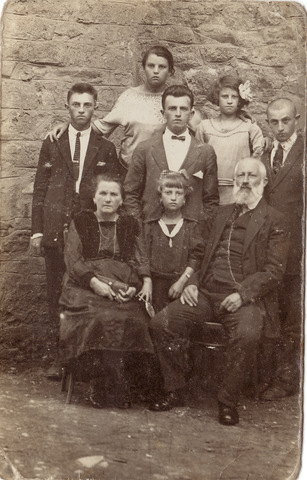
Chaim
Reinstein, his wife Fanja née Amcis (Amcies) and their children,
Okopy, 1920's.
(photo with permission of the family) |
The ethnic split in Okopy Swietej Trojcy in 1921 was 77% Ruthenians, 12% Poles and 11% Jews.
However, judging only by their surnames, it would seem that of the 7 professionals listed in 1927, only one (14%) – the shoemaker, Kuziak - was Ruthenian, four (57%) were ethnic Poles and two (28,6%) were Jews – Kaufman, the owner of the variety shop and Moscisker, the owner of the tobacco shop. The latter also owned a small piece of land and, together with his wife, Genendel-Feige (aka Genia), ran small beer shop for the villagers and a small restaurant for the summer vacationers.
In the 1920’s and 1930's there was also at least one Jewish butcher, Mosze Reinstein (Rajnsztajn), as testified by his cousin, a Holocaust survivor, in a Page of Testimony deposited at Yad Vashem.
|
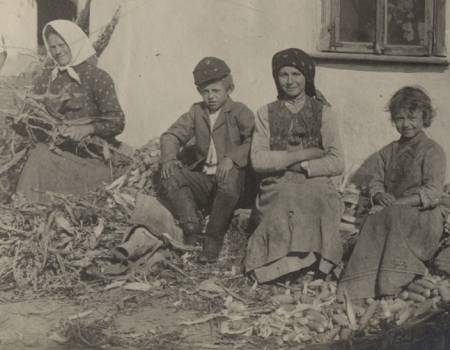
Ukrainian women in Czortkow, 1917. © Tomek Wisniewski, www.bagnowka.com

Ukrainian in Wygnanka, near Czortkow, 1917. © Tomek Wisniewski, www.bagnowka.com |
In the 1930's, the village elders interviewed in June 2010 recalled, there was a Polish primary compulsory school of 4 classes in Okopy. The school master's name, Paulina Prodan and Yaroslava Tsymbalyuk recalled, was Woszynski. Yaroslava rememebred the given names of her two Jewish male classmates: Szioma and Moszko. She also remembered Salka, a blond Jewish girl who, she said, looked very much like Chana Reinstein in the photos I showed her (see above).
All five village elders interviewed in June 2010 were born between 1928 and 1930. None remembered anything about a tobacco shop because, they all said, they were too young to smoke at the time. On the other hand, they all remembered that there was a "poob" (pub, or rather beer shop) held by "Moscisker Stare (the Old Moscisker)" in his house right opposite the Lwow Gate, and this they all remembered, explained Volodymyr Kryvoruchko, because "my father went to fetch beer and I was sent by my mother to fetch my father and so did all the children of the village so we all knew where it was". The Jews and the Poles, he explained, lived inside the fortress, between the two gates, that was called "the town". The Ukrainians lived outside the fortress' compound, in the part that was called "the village".
"Poles, Jews, Ukrainians - at the time, there was no difference." said Yaroslava. To what extent this was true can be also deduced from the fact that Volodymyr's mother’s given name, for example, was Paulina (typically Polish), while his father's was D'mytrow (typically Ukrainian), indicating a mixed marriage. The Polish law in this respect (still in effect) stipulated that the daughters of such marriages follow the mother’s religion/ethnic group and the sons - the father's religion/ethnic group. Likewise, Paulina Prodan’s given name would indicate that, she, too, was probably born to a Polish mother.
Paulina Prodan described Moscisker Stare, my grandfather, as “fair, with low cut hair and an impressive figure”. She, as well as Volodymyr and Mikolai Prodan, remembered how, sitting in his wheelchair, on the terrace where the beer was served, with his stentorian voice, he exercised a tight control over his little kingdom. It was “Genedla i ii chlopci” (“Genendla and her boys”) as they often referred to my grandmother and her sons, who were in charge. |
|
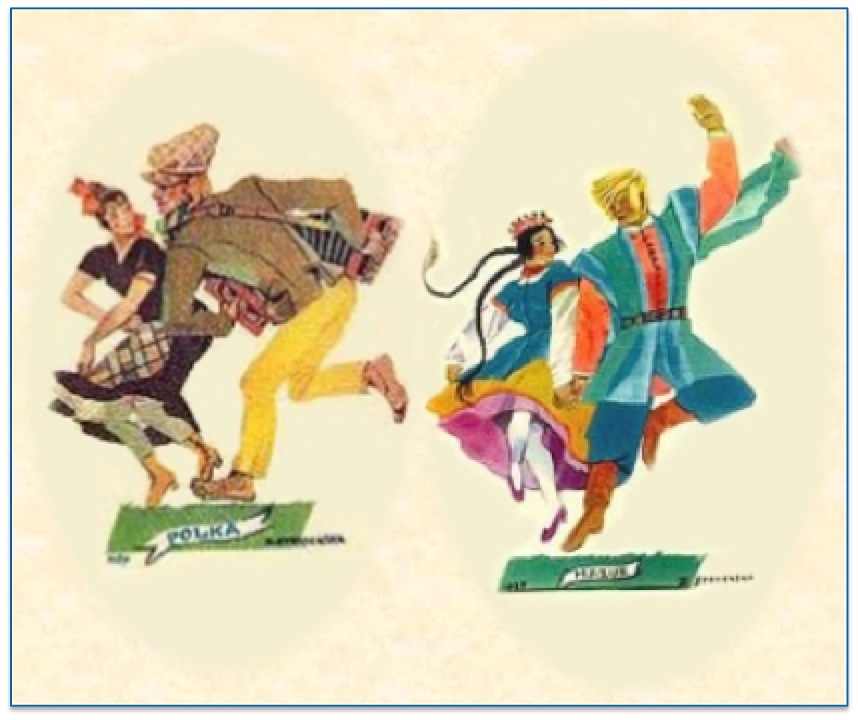
Polish folk dances. Left: Polka, right: Mazurka.
More Polish folk dances at: http://polskiinternet.com/english/info/folk-dance.html
|
Yaroslava, Paulina and Mikolai as well as Volodymyr and his wife, all remembered three Moscisker sons very well: Kuba, Munju and Henju. Henju, remembered Volodymyr, skied very well. Kuba participated in all the festivities of the village, said Paulina Prodan, often came to the dancing with the Polish and Ukrainian girls and, she added with a naughty smile, "was particularly popular"... .
Munju and Henju were well integrated in the village's life as well. They, too, always came "to the dancing with the girls at the cloob" as Yaroslava and Paulina put it. |
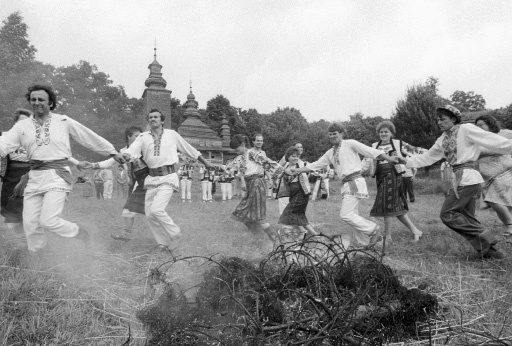
Ukrainian mountaineers dance round the watra ritual structure
© RIA Novosti / www.visualrian.com /
|
"Poles, Jews, Ukrainians - at the time, there was no difference. We lived together" said Volodymyr. "Now there is a difference. But not then". With their own words, all the other four village elders expressed the same idea.
Like the whole region, between September 17, 1939 and June-July 1941, Okopy was under Soviet occupation.
In September 1939, Paulina Prodan recalled, the Poles and the cultivated people of the village (read the Jews) crossed the border into Romania, "because there it was less dangerous and it was nicer there and more peaceful. Then the Russians threw all the other inhabitans over the border line, too. We all stayed on the other side of the border for some 3-4 months. When we returned to Okopy, everything was covered by overgrown vegetation and the roofs disappeared from the houses...".
Then, Yaroslava and Paulina remembered, the teaching language in the school's village was changed from Polish to Ukrainian. After having had 2 years of Polish school, Yaroslava had to start all over again in a Ukrainian preparatory class. Neither of the women remembered what happened to their Polish schoolmaster once the Polish school was closed down and replaced by a Ukrainian one. According to all four village elders interviewed in June 2010, Moscisker Stare continued to own his “poob” and sell beer to the villagers even under Soviet (communist) occupation.
On June 21, 1941, the Nazis attacked the USSR and the invasion began through the former Eastern Polish provinces.
Around December 1941, a letter from Okopy reached Kuba Moscisker’s widow in Warsaw. In it, the former Polish Mayor of Okopy informed Kuba (whose death, in the meantime, he ignored) that, between the retreat of the Soviet Army and the arrival of the German army (around August 1941), his father, Moscisker Stare, was murdered by an axe blow to his head, in the village of Okopy. In 1957, my grandmother’s sister, Beila Brumer née Weissmann, deposited in Yad Vashem a Page of Testimony confirming that my grandfather was murdered in Okopy in 1941.
When interviewing Volodymyr Kryvoruchko in Okopy in June 2010 he first said that Moscisker Stare was sent to Mielnica ghetto by the Germans in 1942. When I said that I had information that he was killed in the village already in 1941, he said that, indeed, Moscisker Stare was killed by an axe blow to his head in the village but that he (Volodymyr) was trying to spare me this detail. Paulina Prodan, too, was adamant that Moscisker Stare was killed in Okopy before the relocation to Mielnica and said that the whole village knew – and talked - about it at the time. None of them, however, could tell me where he was buried. Probably, they said, in the local Jewish cemetery, but they weren’t sure.
Then came Mikolai Prodan and insisted, rather forcefully, that Moscisker Stare was never killed in the village but that he was relocated, with all the other local Jews, in the spring of 1942, to the ghetto of Milenica. “Had he been killed in the village, we would have known where he was buried’ he repeated louder and louder. Volodymyr ended up remodifying his version to fit that of Mikolai and said it must have been in Mielnica that Moscisker Stare was killed by an axe blow to his head. Paulina Prodan, however, stood up to her husband and repeated that the old man was killed right here in Okopy and had never left the village: “in his [wheel] chair he sat, and in his [wheel] chair he remained”.
When further questioned about the relocation to Mielnica, Mikolai Prodan said that, on the day that Okopy Jews were relocated to Mielnica, he personally saw my grandmother, Genendla Moscisker, leaving Okopy on foot, behind the cart carrying the family belongings. However, when I asked him whether he also saw my grandfather leaving the village with my grandmother, he admitted that he did not.
All four village elders told me that until the the spring of 1942, the German garrison stationed in Okopy lived in the building that later became the hospital and that it was my uncle Henju who had to fetch water at the village well and bring it to the German soldiers, in two buckets, every day. They all remembered how frightened Henju was. Volodymyr, whose parents’ house was situated on the street leading from the well to the hospital, said his mother gave Henju something to eat every time he passed near their house. Paulina Prodan said her mother did the same. |
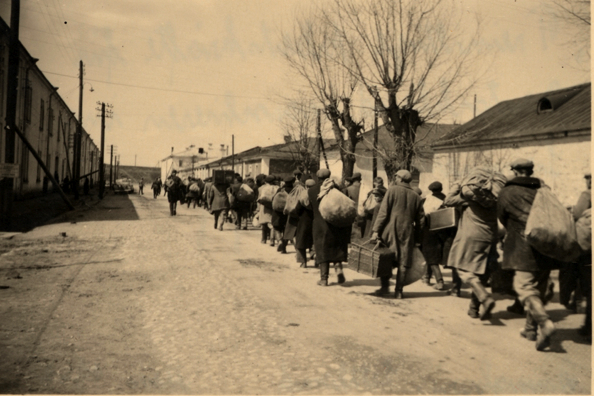
Relocation to ghetto
(source: Unites States Holocaust Memorial Museum online photo archives )
|
In the spring of 1942, “a terribly cold spring”, remembered Mikolai, the 40 Jewish families of Okopy were marched to Mielnica, some 19 kilometers westwards. They were joined there by the Jews of other neighbouring villages. In Mielnica, Mikolai said, they were all herded into a ghetto.
Henju was kept in Okopy to bring the water and work in the Kitchen. With him, said Paulina Prodan, was also working Dora, the daughter of the butcher Moszko. Yes, said Mikola, she was pregnant. The butcher Moszko would be Mosze Reinstein, for whom there exists a Page of Testimony given by his cousin to Yad Vashem. Dora would be his daughter Dwora Reinstein. By the Page of Testimony, she was only about 13 years old at the time. Both Henju and Dora (Dwora) were sent to the ghetto in Mielnica at a later stage but the village elders did not know when exactly. However my father, Munju, said he was in the ghetto with Henju during the last Akcja. "There was a young boy", said Paulina "Sioma, the son of Moszko the butcher. They tied him up to the horses' tails and he was dragged by them". Sioma would be Shmuel Reinstein, Moshe Reinstein's eldest son, and he would have been about 15 at the time. It is unclear when exactly the incident occured but as Moshe Reinstein's cousin testified that all three children were deported to Belzec in 1942, it must have occured either in 1941 or around the liquidation akcja of the ghetto of Mielnica.
|
About the liquidation of the ghetto of Mielnica, Pinkas Hakehilot (Encylopaedia of Jewish Communities), Poland, Vol. II: Eastern Galicia (published by YAd Vashem, Jerusalem, 1980) says the following:
On September 26, 1942 (the first day of Sukkot 5703), the ghetto of Mielnica was liquidated by Gestapo men from Chorostkow and the local Ukrainian police. The Jews were concentrated in the marketplace and were made to kneel with their hands on their necks. The sick, the weak, the handicapped, those who had hidden out and those who tried to escape were summarily murdered in situ. Some 100-300 persons were thus killed in Milenica itself. From the marketplace the Jews were marched to the railroad station of Iwanie-Puste, 3.7 kilometers away. Some wagons transported those who could not walk fast. From this station they were deported to Belzec extermination camp. During the Liquidation Akcja, the Ukrainian rabble actively participated in the hunt for hiding Jews. |
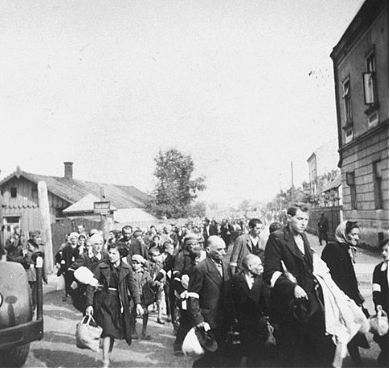
A long column of Jews from the Rzeszow ghetto walks to the train station during a deportation akcja.
(source: Unites States Holocaust Memorial Museum online photo archives )
|
Except for the part relating to the participation of the Ukrainian Police and the Ukrainian rabble in the Akcja which he passed, Mikolai Prodan's description of the liquidation akcja of Mielnica ghetto was pretty much identical to that of Pinkas Hakehilot.
Some of the Jews interned in the ghetto of Mielnica did, however, succeed in escaping the deportation to Belzec that day. |
One cold autumn evening, Volodymyr recalled, his mother was sitting by the window when someone knocked on it from the outside. When she opened it, she saw a man with his hair and beard wildly grown whom she did not recognize. Who are you, she asked. « Ia Munju (I am Munju)» the man replied and Volodymyr’s mother said « come inside very quickly, Munju, because the Germans may come ». Once inside, Volodymyr continued, Munju said « Paulina, give me something to eat ». My father told me about the Polish neighbour who gave him food while he was hiding in the forests near the village. He did not mention her name or I did not remember it. He said that she once gave him a whole chicken thigh. He said he came to her several times for food while he was |
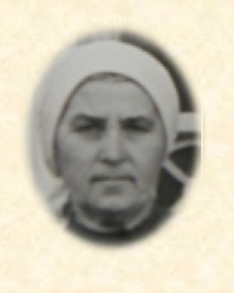
Paulina Kryvoruchko
|
hiding in the forests near Okopy. When I asked Volodymyr about the chicken thigh he said his mother just gave Munju, every time he came, whatever there was in the house and that Munju came several times. He said it was dangerous. "There were horrible stories in the village linked to it. I don't rememebr. Someone was dranwed. Maybe by the neighbour. There was something horrible. I don't want to talk about it". His parents’ house, he later told us, was set on fire by a Ukrainian neighbour, in 1945. That neighbour, said Volodymyr, “at a certain time he was hiding Munju, and then Munju said this neighbour doesn’t want to hide him anymore and doesn’t give him food, that’s why he came to my mother”.
|
Volodymyr’s wife narrated, with tears in her eyes, that her mother and her aunt were once milking the cow in the barn at night with only little light. “They heard sighs and, from somewhere in the barn, came out someone who was hiding there. A Jew. Grynberg. Chaim Grynberg. He said – Ulyana, don’t be afraid, I just want some food, I’m hungry. And they gave him food but asked him to leave because the house was very close to the street, near the church [where the German patrolled daily] and they were afraid. ”
As for the Poles of Okopy, albeit I did ask the village elders about them, I am not sure I fully understood what happened to them during WWII. I seem to have sensed that they have been relocated to another village, further away from the border, already around 1943. However, I am unclear about whether they were made to leave Okopy by force or whether they left voluntarily. Also, I am not sure whether they were moved out by the Germans or fled either the Germans or the Banderowcy (Ukrainian Insurgent Army, so named after its leader, Stepan Bandera). The Banderwocy, said the village elders, had their headquarters in the village opposite Okopy and used to come to Okopy for food supply. The village elders never said anything about Banderwocy’s attacks on Okopy’s Poles. However, there is ample evidence from other sources (e.g., Yad Vashem’s various collections and Yizkor Books) concerning Banderowcy murdering Polish villagers and setting fire to their houses all over Eastern Galicia from early 1943 and on. It is thus not excluded that Okopy Poles, like other Poles from the region, had fled their ancestral village to inland larger villages or towns.
The towns of Mielnica and Skala were both liberated from the Nazis by the Red Army on April 6, 1944. It is thus very likely that Okopy was liberated at the same time or around the same date.
Unfortunately, there is no information concerning Okopy Jewish residents who survived the war in Okopy proper or in its vicinity.
The firstborn of the Mosciskers, Nissen-Kiwe (Nathan) , survived the war in the steppes of Central Asia to where he was exiled from Lwow by the Soviet occupants back in 1940. He returned to Poland with the first transport of the first Repatriation operation (Pierwsza repatriacja), was sent to Walbrzych and from there, in the early 1950’s, immigrated to Israel. Except for uncle Nathan and my father, I could find traces of no other Jewish Holocaust survivor from Okopy.
As already mentioned, except for the three or four (the village elders were not sure of the number) Poles who remained in Okopy after the war, it is presumed that all the others returned to Poland from where they were by the end of the war either during the first Repatriation operation in 1944-1946 or during the second one (Druga repatriacja) in 1955-1959. The last of Okopy Poles, according to the village elders, died of old age several years ago. At the time of airing this web-site (July 2010), I have no way of tracing them or their descendants. If you are in posession of photos, documents and/or stories concerning former Polish residents of Okopy Swietej Trojcy and wish to upload them to this web-site, please do not hesitate to contact me.
The Polish Church, reads Wikipedia Poland, was destroyed in a fire in 1945. When asked about a fire in the village in 1945, Yaroslava said she remembered it. But that was all that was said about the subject. There was no mention, nor sign, of any other house in the vicinity of the church that was burnt in that fire. Another fire, as we have already learned, was set to Volodymyr’s parents’ house in 1956.
Of the Jewish houses in the villages there is not much left. Some of them simply fell into pieces. Others are inhabited and renovated.
My father's house is still there but had changed residents and owners already three times since the war.
First, said the elders, it was a Polish lady. When she died, it was a Ukrainian lady. Now it is inhabited by a Ukrainian family.
My grandparents’ house and the beer shop stood between my father’s house and the road, opposite the Lwow gate.
From the moment its inhabitants were relocated to Mielnica and until the German retreat in 1944, said the village elders,
|
|
the house remained empty, with no door and no windows and looked like a ghost.
In 1944, when the German unit stationed in Okopy began its retreat and needed to enlarge the main road to allow faster evacuation of their tanks, my grandparents' house was torn down.
Nothing was built in its place to this very day and, except for wild grass, nothing is growing there to this very day either. |
Nowadays Okopy is still in the district of Borszczow (now Borshchiv), province of Tarnopol (now Ternopil) and the nearest train station is still at Iwanie Puste. The total population, however, is only 557 persons, all of them Ukrainians.
The village elders still remember the faces and names of the Jews and Poles of the village. When they’re gone, all that will be left of a once multicultural community will be the ruins of the Polish church and the wild grass on the place where once stood the house of Moscisker Stare, Genendla and their five sons.
|
|

